Matuschka
Matuschka, birth name Joanne Motichka (born March 19, 1954) is a New York City photographer, artist, author, activist, and model. Her self-portrait on the Sunday cover of New York Times magazine in 1993 was chosen by LIFE for a special edition entitled 100 Photographs that Changed the World[2] published in 2003 and again in 2011. The artist has been nominated for many awards, including a Pulitzer Prize,[1] and has received dozens of citations, honors, and distinctions for her photographic works and activism since the early 90s.[3] In 2012 Matuschka appeared in Rose Hartman's book Incomparable Women of Style, and in 2011 John Loengard included her in his monograph: The Age of Silver: Encounters with Great Photographers.[4]
Matuschka | |
|---|---|
 Matuschka in 2017, photo by Jesus Jimenez | |
| Born | Joanne Motichka March 19, 1954 |
| Other names | Jersey Jo, Maxi |
| Alma mater | School of Visual Arts, Prescott College |
| Occupation | Artist, Photographer, Model, Singer, Writer |
| Years active | 1972-present |
| Awards | Pulitzer Prize nomination [1], Feature Photography (1994); ABC Person of the Week (1993); Rachel Carson Award (1994); Gold: World Press Foundation (Headline News 1994); Photo District News Nikon Award (1997); Gilda Radner Award (1995); Graphis Best Environmental Award (1996) Life Books Special Edition: 100 Photographs that Changed the World[2] (2003 and 2011); Bunte Magazine Tribute, Women of the Nineties Who Changed the World (1998); etc. |
| Website | www.matuschkathemodelofthefuture.com, www.matuschka.net, www.beautyoutofdamage.com |
Early life: 1954–1970
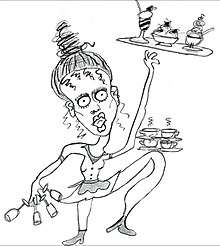
Matuschka was born in New Jersey and raised in poverty in what she described as a "classless lower class home where everyone began to work as soon as they learned to walk."[5] As a kid she constantly drew, and by 9 was making homemade greeting cards and selling them door-to-door. At 12 she worked in a bakery earning 50 cents an hour. When she turned 14 her father, a Port Authority Police officer, lied about her age so she could work as a waitress to help support the family when the matriarch died.
Joanne's mother, a farm hand from Allamuchy Township, New Jersey, succumbed to breast cancer in 1968 at the age of 41. That summer "Joanne" ran away from an increasingly violent and abusive home, changed her name to "Lisa Cross" and began working as a cocktail waitress in Far Rockaway, New York. A year later she returned to New Jersey, and became a ward of the State of New Jersey.[6]
In 1970 she was placed in a foster family with the Marco family of Paramus, New Jersey. Anton Marco was an opera singer who toured Europe with Marlene Dietrich during the Second World War, and later appeared in Woody Allen's film Zelig.[7] His wife, Maureen Marco—a Special Ed teacher and painter who graduated from Washington University—recognized Joanne's raw talent, enrolled her in art classes, provided books from the local library and sent her to Museums in New York City. Mrs. Marco also encouraged Joanne to keep a journal, write poetry, document her dreams, scribe her memoirs and pose for life-sketching classes.[6]
Although Mrs. Marco and Joanne would share a special relationship until the elder's death in 2005, family circumstances prevented Joanne from remaining with the household after 1970. In 1971, Joanne would go on to live in three more foster homes before the Bureau of Children's Services made a decision to send her to Windsor Mountain, a boarding school located in Western Massachusetts in 1971.[6]
Education: 1971–1975
Windsor Mountain Prep School

It is at Windsor Mountain School that Jan Wiener, a European History teacher, nicknamed Joanne "Matuschka"—a version of Motichka—a name which sounded much like her idol, the model "Veruschka".[8]
At Windsor Mountain Matuschka excelled in the arts, winning the Art Prize at Graduation. In 1973 she had her first solo show at the Lenox Library, which was reviewed in The Berkshire Eagle.[6]
The Berkshires

Matuschka lived in Lenox next to Tanglewood and close to Alice's Restaurant where she met Ray and Alice Brock, attending several of their classic Thanksgiving Dinner events. Photographer Don Snyder would become Matuschka's mentor as she became his muse and mentee for the next 30 years.[9]
During the two years she lived in the Berkshires, Matuschka worked as a photography/gallery assistant and apprentice to photojournalist Clemens Kalischer of The Image Gallery in Stockbridge, Massachusetts. She also posed for life sketching classes, regional artists and taught life sketching at Windsor Mountain.[10]
College
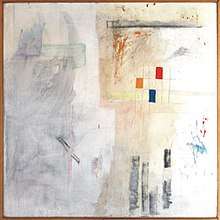
Matuschka was enrolled for the 1973 fall semester at Washington University in St. Louis, Missouri, but at the last minute decided to matriculate at Prescott College—a small, private, liberal, school in Arizona founded by the Ford Foundation. At Prescott she designed an independent curriculum with a variety of regional artists specializing in architecture. Her field studies brought her to the works and sites of Paolo Soleri, Frank Lloyd Wright and Antoni Gaudi. Matuschka frequented Native American Ruins in addition to Arcosanti, Cosanti and Taliesin West—all a short distance from campus.[11]
After taking the course of George Bruce at Prescott, she was invited by Bruce to publish her poetry in a Scottish Anthology called Arkos, which he edited. He selected a suite of Matuschka's poems entitled Visions from a Locked Ward for the 1974 edition.[12]
Matuschka had her second solo show entitled The Tragedy of a Space Condemned at the Bofus Gallery at Prescott College which was reviewed in the Prescott Courier in 1974. This was the beginning of the artist's interest in combining text and imagery.[13]
Prescott College went bankrupt and Matuschka transferred to the School of Visual Arts in New York City the following year.[10]
At SVA Matuschka studied with painters Jennifer Bartlett and Frank Roth.[10] At night she pushed a hack, becoming one of the first and most likely youngest females—or individuals—to drive for a commercial taxi fleet at night.[11] She was hired by Chase Maintenance Cab Company on West 47th Street during New York's most turbulent, crime ridden years.
From 1971-75 the State of New Jersey paid for her tuition to attend both private prep school and college.[14]
The New York years: 1974–1987
Modeling
In 1975, while driving a cab in NYC, a fare suggested Matuschka try Fashion modeling and introduced her to his friend Wilhelmina of the Wilhelmina Modeling Agency. Wilhelmina set her up with agents in Milan and Paris to expand her portfolio. At 21, Matuschka quit both college and taxi driving to pursue a fashion career abroad. While traveling Matuschka often took out her make up and magic markers and made caricatures and cartoons of the people she met, often photographing them first with her SX-70 Polaroid camera.[15]
In the 70s she modeled for Fabrizio Gianni in Italy, Christian Dior in France and Scott Barrie in NYC among others. In the late 70s, Matuschka was the House Model for The House of Julio. In 1978, the great courtier designer, Charles James proclaimed Matuschka to be "The Model of the Future".[16] Videographer Anton Perich frequently filmed Matuschka,[17] and broadcasts featuring her interviews at Bonwit Teller, catwalks and fittings at the Chelsea Hotel (with Corey Hayes[18] and Charles James) and a 'couch cutting creation out of styrofoam'[19] with John Chamberlain (commissioned by the Hershey Family) at the Dakota have been aired on Cable TV, Channel J, since the 70s. Extensive video and still footage of Matuschka working with Charles James (by Anton Perich) will be incorporated into a new documentary entitled Beneath the Dress.[20]

In print, Matuschka has worked with some of the world's renowned photographers including Nick Knight for Dazed and Confused,[21] Robert Maxwell for More Magazine and Nadav Kander for his book, Beauty's Nothing. She posed for Gerard Malanga (of Warhol's factory), Don Snyder, Push Pin Studios, Bill Cunningham (The New York Times), Jeff Dunas for Oui Magazine and was featured in Mr. Dunas' book, Mademoiselle, Mademoiselle! in 1983. In the 70s and 80s she apprenticed with Town & Country / Harper's Bazaar photographer Bill Silano,[22] perfecting her printing skills in the darkroom. Matuschka's experience as a photographic assistant and model was essential to her development both behind a camera and in the darkroom. Working alongside masters such as Clemens Kalischer, Bill Silano and Don Snyder, she learned the art of chemically toning and manipulating silver gelatin prints.
Author
In the mid-70s, Matuschka began pursuing a writing career and spent many nights at Elaine's, the Carlyle Hotel, the St. Regis and P.J. Clarke's where she met and worked with a variety of writers and artists including: Salvador Dali, Norman Wexler (who wrote Saturday Night Fever in an apartment across the hall from her flat), gonzo journalist Anthony Haden-Guest, writer, sports publisher and socialite George Plimpton, Michael O'Donoghue (Saturday Night Live), producer Bertrand Castelli, socialites Ted Otis and the Van de Bovenkamps and bestselling author Joseph DiMona.[23] Joe DiMona introduced her to Pine Associates Literary Agency in 1978 and the father/son duo represented her intellectual properties for a brief time. Excerpts of her unpublished memoir were reprinted in three issues of OUI Magazine, a subsidiary of Playboy Magazine, in 1981. One feature included an introduction by Anthony Haden-Guest and a pictorial spread by Jeff Dunas. She received a PEN Writing grant during this time. Since the 80s Matuschka's writings and poetry have appeared in dozens of publications and books worldwide from Glamour Magazine, to Oxford anthologies and academic journals on a wide range of subjects.[24]
Music
In the 80s, Matuschka began combining her poetry and prose with music she wrote. As a performer she became known as "Jersey Jo Matuschka".
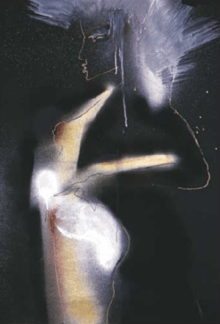
Producer Jay Rifkin (Rain Man, The Lion King) first of Miracle Express and later Clinton Studios in NYC and Media Ventures in Los Angeles recorded, produced and worked with "Jersey Jo" and her band in the mid-to-late 80s. "Jersey Jo" performed at Trax, The Bitter End, Kenny's Castaways, The Pyramid Club and Danceteria. In 1987, she won first place in the "rock off" contest in the Dominican Republic, playing with Hilly Michaels, former drummer of Sparks. During this period Matuschka created a series of works on paper entitled Whores Galore based on the red light district. The collection was sold out.[25]
The Ruins
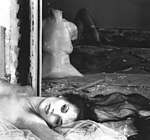
And when it's over before noon before the coffee and the spoon when one thing leads to another and we don't know what to do with the ruins
"The Ruins" - Matuschka[26]
In 1987, Matuschka's Record Company asked her to design the cover for her album jacket. Although the company went bankrupt, Matuschka proceeded making images to illustrate her music. In the late 80s she chose photography as her main medium after taking pictures of herself in abandoned buildings based on a song she wrote called "The Ruins".[26]
Photography
The Ruins series was published in many fine art magazines internationally, including the cover of P/F (Professional Photography)[27] while exhibits were mounted at the Center for Photography at Woodstock and the Photographic Museum of Helsinki.[28] The Ruins, based on Matuschka posing alongside plaster casts of her body in abandoned buildings, is considered her first major work known to the public.
Health and activism
Health
Matuschka was mis-diagnosed and almost died of hepatitis A in 1968. A near fatal bike accident left her with many broken bones, a severe back injury and traumatic brain injury in 1989. Two years later, at the age of 37, she was diagnosed with breast cancer, undergoing a mastectomy and 6 months of chemotherapy. Matuschka received financial aid from Change, the Robert Rauschenberg Fund, which helps artists facing intense hardships during her injury-related rehabilitation and cancer therapy. In 1991 Matuschka enrolled in the Kushi Institute, Beckett, Mass. and studied macrobiotics with Michio Kushi and Denny Waxman[29] for 10 years.
Grassroots
In 1991, while undergoing chemotherapy, Matuschka discovered her mastectomy was unnecessary because the doctor did not tell her a lumpectomy was an option. She immediately turned her dismay with the medical profession into a unique form of activism. She began making posters and taking pictures of herself in a variety of 'styles' to bring greater attention to what was then called "The Silent Epidemic".
Matuschka joined many breast cancer groups including SHARE cancer support, 1 in 9, National Organization for Women (N.O.W)., National Alliance of Breast Cancer Organizations (NABCO) and Women's Health Action and Mobilization (W.H.A.M.!). Her alliance with W.H.A.M.! proved to be the most significant.
W.H.A.M.!
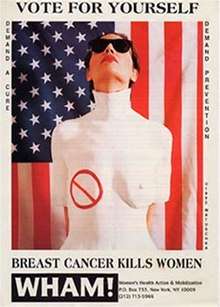
Established in 1989, Women's Health Action and Mobilization (W.H.A.M.!) was an American activist organization based in New York City that employed direct actions to protest 'anti abortion sentiment', and endorsed pro-choice healthcare for both men and women. The group worked closely with the AIDS Coalition to Unleash Power (ACT UP) during the AIDS crisis. W.H.A.M.! become most famous in 1991 for draping the Statue of Liberty with a "pro-choice banner"[30] (with the help of a loaned helicopter) the same year Matuschka joined the group. Matuschka spearheaded the Breast Cancer Action Movement (B.A.M.!) at W.H.A.M.!, and worked closely with Dr. Susan Shaw in designing a series of breast cancer awareness posters that would be distributed and wheat pasted[31] on buildings, trucks and barricades in the greater New York Area.
Matuschka's first poster for the group was an illustration of the Statue of Liberty with the 'no' symbol painted over Lady Liberty's right breast. In 1992, W.H.A.M.! sponsored Matuschka's image Vote for Yourself[32] as a glossy, eye-catching mass media poster. WHAMMERS, as they were known, wheat pasted this political poster at dozens of breast cancer rallies and demonstrations throughout the greater New York region. Fox Five News was the first mainstream media platform to air W.H.A.M.!'s breast cancer actions—using artwork created by Matuschka over a three-year period[33] before pink ribbons became the symbol for the disease. A year later Vote for Yourself caught the attention of The New York Times photo editors.
The New York Demonstrations: 1991–1994
In 1991, the artist attended many rallies and demonstrations throughout the New York Area including: 1) The first Central Park Walk sponsored by SHARE (1991), 2) Central Park Run Sponsored by "Race for the Cure" (Susan G. Komen Foundation) (1991), 3) Central Park Demonstration sponsored by various grassroots groups (1992), 4) Riverside Rally sponsored by SHARE (1992) and 5) the Long Island Breast Cancer Coalition sponsored by 1 in 9 (1992) Great Neck Court House.
In May 1993, W.H.A.M.! sent Matuschka with a suitcase of political posters to the National Breast Cancer Coalition conference held in Washington D.C. to represent the group. Susan Ferrara, a writer from The New York Times, was covering the three-day event. On the last day of the convention, she spotted Matuschka wearing the Vote for Yourself on her body much like a sandwich board at a strike. Ms. Ferrara interviewed the artist for the article she would title: "The Politics of Breast Cancer".
That August, The New York Times decided to run Ms. Ferrara's article as a feature in their Sunday Times Magazine and needed an illustration for their cover. Art director Janet Froelich selected Matuschka's photo, Beauty out of Damage, showing her mastectomy and face—a decision that turned out to be controversial[34]—and sparked debate about the treatment, awareness and depiction of breast cancer throughout the world.
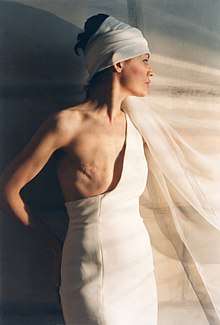
"Activists like Matuschka—a tall, striking artist in New York—set out to shock. As a member of a small group called W.H.A.M! (Women's Health Action and Mobilization), Matuschka makes art of her mastectomy with poster-size, one breasted self-portraits that force people to see what cancer does. Though some of her mainstream sisters are discomforted by the graphic images, they admire her determination. As she says, 'You can't look away anymore."
- — Susan Ferrara[35]
This historical publishing decision[36] made headline news for showing a "topless" cover girl on a mainstream magazine, and was viewed by many as ending the silence, shame and concealment for millions of women regarding their bodies and how they are portrayed by the media.[37] Breast Cancer advocates and activists were here to stay, and the breast cancer movement had been officially launched.[38]
After The New York Times Sunday Magazine was published, Matuschka participated in many demonstrations throughout the country, including one sponsored by The Harley Davidson Motorcycle Club of Manhattan in conjunction with the American Cancer Society, and another one organized by GreenPeace on the Rainbow Warrior Ship in 1995.
Greenpeace
In 1995, Greenpeace commissioned Matuschka to create a poster directed at Time Life to cease using chlorinated paper. Matuschka designed a poster similar to Vote For Yourself, which incorporated a cast of the artist's torso. The artist replaced her missing breast with a clock on the plaster cast, labeled the image Time For Prevention and created a facsimile of Time Magazine for the poster.
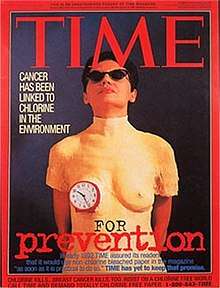
Greenpeace sent Matuschka to the Great Lakes Region, where the Rainbow Warrior ship was docked to speak with civilians, to hand out these informative political posters. Greenpeace's effort to bring greater awareness to the link between chlorinated paper, dioxin and cancer was a huge success. Their crusade ended in NYC when members of Greenpeace scaled the Time Life building and were arrested. Massive media coverage included Matuschka's iconic poster, and the artist received numerous awards and citations. Additionally, these posters were wheat pasted throughout the country and used extensively in the "Chlorine Free" campaign initiated in the Great Lakes area. Time For Prevention is in the permanent collection at the Cooper Hewitt, Smithsonian Design Museum located in New York City, and won best environmental poster of 1996 by Graphis Inc..[39]
Reconstruction
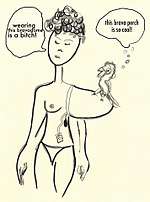
Matuschka began breast reconstruction in 2013, 22 years after her mastectomy operation, using a new system: the Brava /Fat Grafting Method,[40] which was experimental and has not been approved by the FDA at this time.
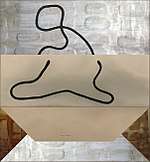
This procedure required 6 hospitalizations and the use of the external Brava apparatus with extensive fat grafting over a three-year period. The reconstruction, which started in 2013, was completed in 2016. CBS News Sunday Morning (with Martha Teichner[41]) aired a special with the artist on September 23, 2013, entitled The Model and the Mastectomy.[42]
Bagit!
A book entitled Bagit!, with an introduction by Anthony Haden-Guest and published by Hard Press Editions,[43] was released in 2009. The abstract art in this book pertains to shopping bags in which the artist has removed all branding, and replaced logos and labels with fine art. The sex appeal of luxury products and brand name obsession is based on the gospel of consumerism: "I am what I buy", or as Matuschka puts it: "you are what you bag."[44]
Abstract works
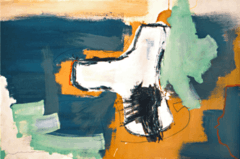
Since the turn of the century she has returned to abstraction, her primary art form. She credits the artist Jennifer Bartlett, who taught her to be responsible for every square inch of the surface one's working on. When she began studying at SVA, she switched from figurative work to abstract painting. "I wouldn't have discovered my main infatuation, or jazz, if not for Jennifer", the artist once wrote.[14]
"In revisiting the world of abstraction and color she has also revisited her old stomping grounds, the Berkshires. And despite the fact that everybody knows her, it is incorrect to say they know her work, at least her current work." -Ed Bride, The Artful Mind 2006[45]
Lectures and workshops
Matuschka exhibits and gives workshops at Universities and Photo Festivals throughout the world. She has spoken at Harvard, Columbia, Yale, Museum of Art Fort Lauderdale, Florida and The Art Cultural Center (Malaga, Spain),[46] to name a few.
Permanent collections
The Cincinnati Museum for Art; Cincinnati, Ohio
Musée de l'Élysée; Lausanne, Switzerland
Cooper Hewitt, Smithsonian Design Museum; NYC, NY[47]
National Museum of Women in the Arts; Washington, DC[48]
Photographic Museum of Helsinki; Finland
Hällisch-Fränkischen Museum; Schwäbisch Hall, Germany[49]
World Press Photo Foundation; The Netherlands[50]
Miniature Museum; Amsterdam
Fleming Museum of Art; Burlington, Vermont
Center for Photography at Woodstock; NY
Center for the Study of Political Graphics; Los Angeles, CA
Northwestern University; Evanston, IL
Henry Buhl Foundation; NYC, NY
Broadway Video Enterprises; NYC, NY
Concord Hospital; Concord, New Hampshire
Awards and honors
Special Citations, Honors, and Tributes
Pulitzer Prize nomination, Feature Photography (1994)[54]
ABC Person of the Week, Worldwide News with Peter Jennings (1993)[55]
The Photographs (30 years of the New York Times most important photos published in the Sunday Magazine) edited by Kathy Ryan; Published by Aperture Foundation (NYC) (2011)[56]
Life Books Special Edition: 100 Photographs that Changed the World; Life Inc. (2003 and 2011)[57]
Edición de Aniversario SEMANA Magazine 30th Anniversary 30 Anos Imagines; Columbia, South America (2012)
Bunte Magazine Tribute (Germany); "Women of the Nineties Who Changed the World" (1998)
Awards[58]
1978, PEN Writers Grant
1989, Salmagundi Fellowship
1994:[59]
Gold, People in the News; World Press Photo Foundation, the Netherlands
Front Page Award; Newswomen's Club of New York
Judges Special Recognition, Magazine Cover; Society of Newspaper Design
Gold, Photojournalism Feature; Society of Newspaper Design
Gold, Society Production Designers
Silver, Art Director's Club
Judge's Special Recognition, Cover; Society of Newspaper Design
American Photography Top Ten
Editorial Awards; Communication Arts Photography Annual
Rachel Carson Award; Rachel Carson Institute, Chatham College, PA
1995:
Catalogue Grant; NYFA:New York Foundation for the Arts
Design Merit; Potlatch Corporation
Juror's Merit Award; Laguna Gloria Art Museum, TX
1996:
Gold, Photographs Only; The Visual Club, NYC
Best Environmental Poster of the Year; Graphis Inc. Poster Annual
NYC Fellowship; Art Matters Inc.
Advertising and Design Club of Canada Honors
Photographer's Fellowship; Center for Photography at Woodstock
1997:
How Design Annual Merits; Business Collateral
PDN/Nikon Self Promotion Award; Photo District News
1998, Y2K Books: Certificate of Excellence; University of California Press
2000, Javelina Award (Lifetime Achievement Award); Prescott College
Humanitarian Awards
1993, Citation; Borough of Manhattan President
1994 :
Humanitarian Award; Mt. Sinai Hospital Service Club
Mayoral Proclamation; City of Cincinnati
Jonquils Award; Duke University, NC*
- In 1994 Gene Wilder and Matuschka were notified they would be receiving the Jonquils Award from Duke University: due to prior commitments, neither were able to attend and the award was given to another.
1995:
Gilda Radner Award; Wellness Community, Boston, MA
Certificate of Recognition; California State Senator
1996:
Award for Activism; Joanne Rathgeb Memorial
Certificate of Recognition; Kennedy Center Very Special Arts
Catalogues
1994, YWCA of Cincinnati (Award)
1996, Matuschka; New York Foundation for the Arts, NYFA (Award)
2011, ¿Heroínas o Víctimas?, Matuschka Fotografías 1991-2003; Fotomanias (Malaga Spain)
Exhibitions
Matuschka's work has been included in 93 international exhibitions, both solo and group, since 1972[60] including the New York Historical Society, Musée de l'Élysée, the Fratelli Alinari Museum of the History of Photography, The National Museum of Women in the Arts, Culturgest, The Frauen Museum, The New Art Center, The Salt Lake City Art Center, The World Press Photo Exhibition, The Montreal Museum of Fine Arts, The G. Ray Hawkins Gallery, the Jean Albano Gallery, the Hallisch-Frankischen Museum, Anthology Film Archives, Kulturkreis Höxter-Corvey Schloss GmbH, the Cooper Hewitt, Smithsonian Design Museum, the Center for Photography at Woodstock, The American Institute of Graphic Arts, The Parrish Art Museum, The Fleming Museum of Art, The Glenbow Museum, and the Cincinnati Art Museum.
Universities and colleges that have exhibited her work include The University of Michigan, Texas A&M University, University of the Arts (Philadelphia), Fordham University, University of Colorado Boulder, Southwest University of Visual Arts (formerly known as the Art Center Design College), Lyndon State College, Tulane University, University of Maryland, Baltimore County, Miami Dade College among others.
Covers
Matuschka's work has been featured on the cover of 26 magazines between 1988 and 2010.[61] including The New York Times Sunday Magazine, Maclean's, P/F (Professional Photography), Foto Magazine, EMMA, NEWS (Austria), Max (German), and Bad Girls and Sick Boys (published by UC Press).
Medical malpractice
In 1993 Matuschka sued[62] her breast cancer surgeon for malpractice for performing an unnecessary mastectomy.[63] She claimed and proved that the doctor had 'mis-transcribed' her pathology report into her chart and gave her incorrect information regarding her diagnosis. The defense team argued that Matuschka's career had benefited from the needless surgery and urged the jury not to award her any money because she had been more successful with one breast than two. Although the jury found in her favor, her award was substantially reduced and she chose to forfeit another trial on damages. The outcome of the lawsuit was made public and covered widely in the press. At the time Matuschka believed her lawsuit would help launch the second phase of her activism: she felt many mastectomies were being performed unnecessarily and women should be made aware of other options. She also wanted to create a law that made it mandatory for patients to receive their pathology reports immediately after surgery. As the artist put it, "I lost a breast and the world gained an activist."[64] However, prophylactic mastectomies were becoming fashionable and Matuschka's second phase of activism failed. She received bad press, began to fade from the 'breast cancer scene' and pursued another direction with her art.[65] Nevertheless, she made case history, set a precedent and subsequent mastectomy malpractice lawsuits referred to Matuschka's case when settling breast cancer lawsuits.[66]
References
- Gayle A. Sulik (18 October 2012). Pink Ribbon Blues. OUP USA. p. 316. ISBN 978-0-19-993399-0. Retrieved 2 October 2017.
- 100 Photographs that Changed the World. New York, Life Books, 2011. p.90-91
- "Matuschka Awards". matuschka.net. Retrieved 27 October 2017.
- "Matuschka & Co." Matuschka & Co. - APA Member - American Photographic Artists, apanational.org/find-a-member/profile/m304001/ Accessed 2 Oct. 2017.
- Haden-Guest, A. (1981, September). The Author as Model: Matuschka. Oui, 10(9), 100-109.
- http://www.matuschka.net/BioPage.html
- "Anton Marco". IMDb. Retrieved 27 October 2017.
- Chartock, Roselle Kline (2014-10-21). Windsor Mountain School: A Beloved Berkshire Institution. ISBN 9781625849762.
- http://www.berkshirefinearts.com/09-13-2010_photographer-don-snyder-1934-2010.htm
- http://www.berkshirefinearts.com/05-21-2013_matuschka-artistic-activist-activist-artist.htm
- http://www.prescott.edu/experience/stories/joanne-motichka.php
- Henrie, Samuel Nyal (2009). Uncommon Education: The History and Philosophy of Prescott College, 1950s Through 2006. ISBN 9781604940213.
- http://www.matuschka.net/Collections.html
- http://matuschka.net/BioPage.html
- "Matuschka Portrait Gallery". www.matuschka.net. Retrieved 27 October 2017.
- Perich, Anton. "Charles James, Matuschka & R.Couri Hay at the Chelsea Hotel 1977." Youtube, 23 July 2008, www.youtube.com/watch?v=OAeTHyCSFuU. Accessed 2 Oct. 2017. "Matuschka is the Model of the Future," 1:58-2:04
- Perich, Anton. "Charles James, Matuschka & R.Couri Hay at the Chelsea Hotel 1977." Youtube, 23 July 2008, www.youtube.com/watch?v=OAeTHyCSFuU. Accessed 2 Oct. 2017
- "Actors". Corey Hayes Photo. Retrieved 27 October 2017.
- https://www.youtube.com/watch?v=acJ4Fdihvjk
- https://www.youtube.com/watch?v=OAeTHyCSFuU
- Newsome, Rachel, and Nick Knight. One in Ten. Dazed, Dec. 2000, www.dazeddigital.com/fashion/article/4346/1/one-in-ten Accessed 2 Oct. 2017.
- http://www.harpersbazaar.com/fashion/photography/g3619/bill-silano-covers/
- "Joseph DiMona, 76, Writer; Co-Author of Haldeman Memoir". The New York Times. 11 November 1999. Retrieved 27 October 2017.
- http://www.matuschka.net/BIBliographPage.html
- http://www.matuschka.net/FINALWhoresGaloreVert.html
- "Matuschka RUins". www.matuschka.net. Retrieved 27 October 2017.
- "Pf.nl - Professionele Fotografie vakblad, website & nieuwsbrief". Pf. Retrieved 27 October 2017.
- Giuliano, Charles. "Matuschka Maimed, Claimed and Famed." Berkshire Fine Arts, Berkshire Fine Arts, 21 May 2013, www.berkshirefinearts.com/05-21-2013_matuschka-maimed-claimed-and-famed.htm. Accessed 2 Oct. 2017.
- "Denny Waxman - World-Renowned Macrobiotic Counselor, Author of Macrobiotic Book, and Speaker". dennywaxman.com. Retrieved 27 October 2017.
- "Guide to the WHAM! (Women's Health Action and Mobilization)." Guide to the W.H.A.M.! (Women's Health Action and Mobilization) Records TAM.162, NYU; Tamiment Library and Robert F. Wagner Labor Archive, Sept. 2010, http://dlib.nyu.edu/findingaids/html/tamwag/tam_162/bioghist.html Accessed 2 Oct. 2017.
- Carroll, Tamar W. "Critical Planning Summer 2007 31 Sculpting the Social Geography of Lower Manhattan: Artists and AIDS Activists in the 1980s and 1990s." UCLA Critical Planning, vol. 14, June 2007, pp. 31–46. www.academia.com, https://www.academia.edu/download/35973785/Carroll_UCLA_Crit_Plan_v14.pdf Accessed 2 Oct. 2017. p.42
- "Vote for Yourself". www.matuschka.net. Retrieved 27 October 2017.
- Susan Hogan, ed. (1997). Feminist Approaches to Art Therapy. Psychology Press. p. 57. ISBN 978-0-415-14840-5. Retrieved 2 October 2017.
- Rosolowski, T. A. Woman as Ruin. American Literary History, vol. 13 no. 3, 2001, pp. 544-577. Project MUSE, http://muse.jhu.edu/article/1938
- http://www.beautyoutofdamage.com/nytimesaug151993.pdf
- "The Times Magazine Cover That Beamed a Light on a Movement".
- Schmich, Mary. "Picture Unleashes A Building Storm." The Chicago Tribune, 18 Aug. 1993, http://articles.chicagotribune.com/1993-08-18/news/9308180163_1_breast-cancer-matuschka-mastectomy-scar. Accessed 2 Oct. 2017.
- Rosolowski, T. A. "Woman as Ruin." American Literary History, vol. 13 no. 3, 2001, pp. 544-577. Project MUSE, http://muse.jhu.edu/article/1938
- http://matuschka.net/awardsPage.html
- Mestak, Ondrej; Mestak, Jan; Bohac, Martin; Edriss, Ahmed; Sukop, Andrej (6 December 2013). "Breast Reconstruction after a Bilateral Mastectomy Using the BRAVA Expansion System and Fat Grafting". Plastic and Reconstructive Surgery Global Open. 1 (8): e71. doi:10.1097/GOX.0000000000000022. PMC 4186296. PMID 25289266.
- "Martha Teichner". Retrieved 27 October 2017.
- http://www.cbsnews.com/8301-3445_162-57599027/the-model-and-the-mastectomy-baring-scars-then-and-now/
- https://openlibrary.org/publishers/Hard_Press
- "Bagit!". matuschka.net. Retrieved 27 October 2017.
- Bride, Edward. "Matuschka, Artistic Activist, Activist Artist - Berkshire Fine Arts". www.berkshirefinearts.com. Retrieved 27 October 2017.
- http://nycculturestyle.blogspot.com/2013/05/a-body-biography-matuschka-photo-exhibit.html
- https://collection.cooperhewitt.org/people/18041617/objects/
- https://beta.worldcat.org/archivegrid/collection/data/919048766
- http://www.staletapraha.cz/media/2013_2/clanky-cele/sp-2-2013-05-culikova-botanika.pdf
- https://stage.worldpressphoto.org/search/images?search=Breast--Cancer&field_fast_tags_tid_selective[]=6588281
- http://www.agcontemporaryart.com/events/matuschkas-retrospective-event.html
- https://www.sohnfineart.com/workshops-2013
- http://www.matuschka.net/FINALBODSGallery.html
- Marchessault, Janine; Sawchuk, Kim (2013-10-18). Wild Science: Reading Feminism, Medicine and the Media. ISBN 9781136294587.
- http://www.berkshirefinearts.com/05-21-2013_matuschka-maimed-claimed-and-famed.htm
- "The New York Times Magazine Photographs". www.goodreads.com. Retrieved 27 October 2017.
- "100 Photographs That Changed the World (100 Photographs That Changed The World.pdf) - PDF Archive". www.pdf-archive.com. Retrieved 27 October 2017.
- http://www.matuschka.net/awardsPage.html
- http://www.beautyoutofdamage.com/Aboutphoto.html
- "Matuschka Resume". matuschka.net. Retrieved 27 October 2017.
- "Matuschka Covers". www.matuschka.net. Retrieved 27 October 2017.
- "Joanne Motichka v Hiram Cody". Retrieved 27 October 2017.
- "Artist Sees Hope in Mastectomy Ruling". The New York Times. 28 March 1999. Retrieved 27 October 2017.
- Potts, Laura (2001). Lies, Damn Lies and Public Protection: Corporate Responsibility and Breast Cancer Activism. Journal of International Women's Studies, 2(3), p.3; http://vc.bridgew.edu/jiws/vol2/iss3/1
- http://www.matuschka.net/GlobalScrollingGalleryPageNov6.html
- https://law.justia.com/cases/new-york/appellate-division-first-department/2010/2010-08982.html